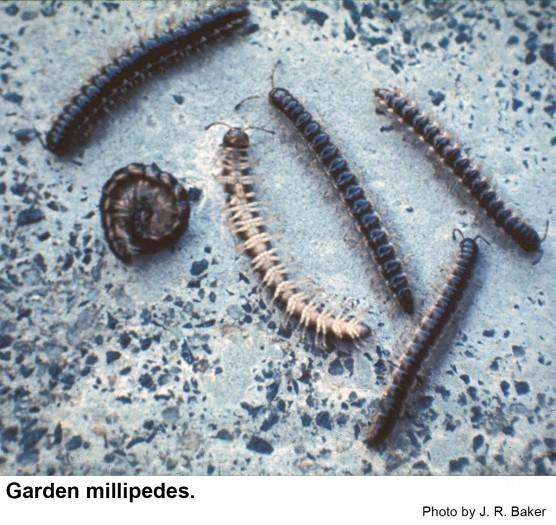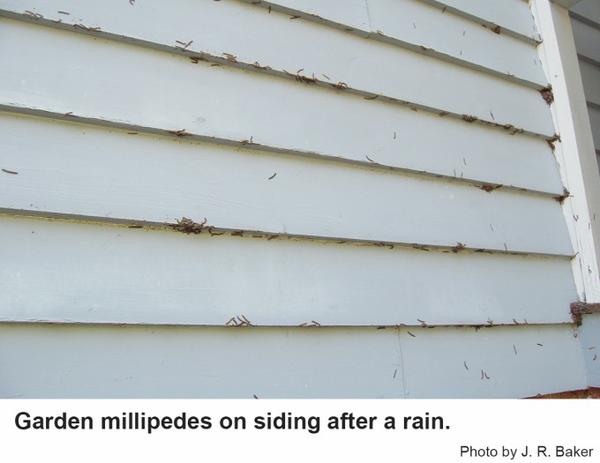Description and Biology
The garden millipede, Oxidus gracilis, is also called the greenhouse millipede and the flat-backed millipede. Millipedes lay their eggs in the soil in the spring. Newly hatched millipedes are very small and have only six legs. They add body segments (each with four legs) with every molt until they have 60 legs or more. Individuals may live for several years. Millipedes prefer dark, cool, moist environments rich in organic matter, and they breed in compost piles, mulch, rotting logs, or soil under logs and stones. They are usually unnoticed because they live in these relatively hidden habitats. However, garden millipedes can appear in very large numbers outdoors (and indoors!). We have heard from folks who have swept up peck basket quantities of millipedes from their drives and patios day after day. Apparently millipedes build up in the yard and surrounding woods until the population is very large. Then the next time it rains, they emerge onto walks, patios, drives and crawl into dwellings. On the other extreme, sometimes hot, dry weather can also cause millipedes to invade buildings.
Host Plants
Garden millipedes feed only on decaying organic matter and consequently do not harm living plants unless the soil dries out to the point that the millipedes then feed on roots to obtain moisture. Occasionally they damage soft-stemmed plants in gardens and greenhouses. They also secrete cyanide gas when they are alarmed, so be careful when handling large quantities of millipedes.
Residential Recommendation
We have had conversations with folks so desparate for millipede control that they have turned their yards into virtual toxic waste sites with such legal and illegal pesticides as chlordane, Dursban, Sevin etc. Chlordane (even at extraordinary rates) does not seem to have any effect on millipedes. For long term management, Dr. Michael Waldvogel recommends minimizing moisture and removing debris especially around homes, greenhouses, and gardens. Consider using inorganic mulches such as gravel for better drainage. Furthermore, dethatch turfgrasses and mow regularly to make the lawn less suitable for millipedes. Once indoors, millipedes do not survive long. Sweep or vacuum them up—there is no use in trying pesticides to control them.
References
- Secretion of Benzaldehyde and Hydrogen Cyanide by the Millipede Pachydesmus crassicutis (Wood). Blum, M.S. and J. P. Woodring. 1962. Science Vol. 138 no. 3539: pp. 512-513.
- Controlling Millipedes in and Around Homes. Waldvogel, M. and P. Alder. 2019 (revised). Household Pests. NC State Extension Publications.
- Sowbugs, millipedes and centipedes. Hahn,J. and M. Ascerno. 2018 (reviewed). University of Minnesota Extension.
- Extension Plant Pathology Publications and Factsheets
- Horticultural Science Publications
- North Carolina Agricultural Chemicals Manual
For assistance with a specific problem, contact your local N.C. Cooperative Extension Center.
The Factsheet has not been peer reviewed.
Publication date: May 1, 2013
Reviewed/Revised: Sept. 17, 2019
Recommendations for the use of agricultural chemicals are included in this publication as a convenience to the reader. The use of brand names and any mention or listing of commercial products or services in this publication does not imply endorsement by NC State University or N.C. A&T State University nor discrimination against similar products or services not mentioned. Individuals who use agricultural chemicals are responsible for ensuring that the intended use complies with current regulations and conforms to the product label. Be sure to obtain current information about usage regulations and examine a current product label before applying any chemical. For assistance, contact your local N.C. Cooperative Extension county center.
N.C. Cooperative Extension prohibits discrimination and harassment regardless of age, color, disability, family and marital status, gender identity, national origin, political beliefs, race, religion, sex (including pregnancy), sexual orientation and veteran status.



